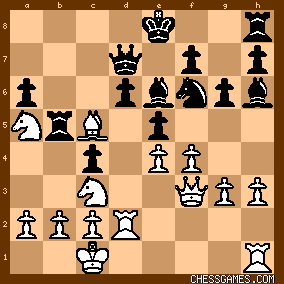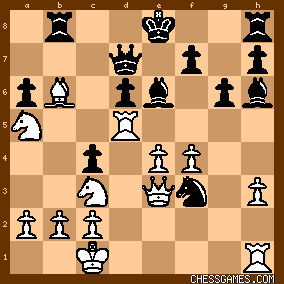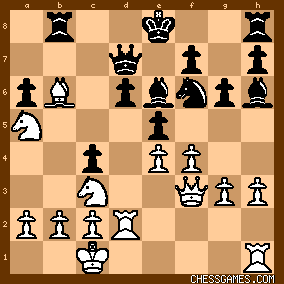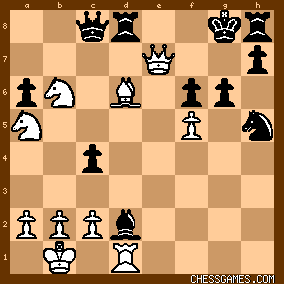|
< Earlier Kibitzing · PAGE 3 OF 3 ·
Later Kibitzing> |
| Jul-03-10 | | dzechiel: White to move (20?). Material even. Very Difficult. I never even considered the key move. And, in retrospect, it's obvious. <sigh> |
|
| Jul-03-10 | | fischer2009: @ azaris
13 Na5 is proved to be the best move in the position and is the reason y dis line is seldom chosen by black dese days; |
|
| Jul-03-10 | | Once: When I was a small boy, maybe seven or eight years old, I was overjoyed when Uncle Barry came to visit. You see, Uncle Barry was the first real person that I had ever played. I had learned the moves from a book - Irving Chernev's "Logical Chess". But no-one else in my school or at home could play. And that made Barry very special indeed. What is more Uncle Barry was a Very Good Player (according to my Mum) because he knew the hidden secrets of chess strategy (again, according to my Mum). And of course, in the very first game we played, he beat me. I tried my best, used all the stuff I thought I had learned from Chernev, crinkled my little forehead until it hurt, but he still won. And then he did that Uncle thing. He gave me an enigmatic smile and asked "do you want to know why you lost?" Be still my beating heart! At last, I was about to be taught the fabled secret of chess strategy! This was Morphius instructing Neo, Obi-Wan teaching Luke, David Carradine as a Shaolin monk ("Ah, grasshopper!"), it was Baloo and Mowgli picking prickly pears with the claw, Tarzan being taught by the apes. Except of course that the Matrix and Star Wars hadn't been made yet, but hopefully you get the point. And what were his immortal words of wisdom, passed on to a tremulous child? From memory, they went something like this: "It's all about the middle of the board, see? Those four squares in the centre. So you need to get your rooks onto king one and queen one to attack those squares. And the best way to do that is to castle queenside and then bring your other rook to the king one square." And that, it turned out, was the sum total of Uncle Barry's knowledge of chess strategy. In every game, he would castle long to bring his queen rook to d1 (or d8 as black), park his king rook on e1/ e8, and then ... hope that something would turn up. I was puzzled. Here was a strategy that Chernev hadn't mentioned, and according to Uncle Barry, it was the only strategy you needed to know - the holy grail of chess. We played two more games and I won them both (largely because Uncle Barry left his pieces en prise and couldn't spot a knight fork when it was staring him in the face). It was the one and only time that we played chess together. For some strange reason, he never wanted to play again and I wasn't too keen for more of his "wisdom". As a bookish boy, I went from "Logical Chess" to "The most Instructive Games of Chess ever Played" and was then blown away by "My Sixty Memorable Games". Uncle Barry and I didn't mention chess much after that. But the years pass with frightening and inevitable speed and nearly 40 years later Uncle Barry is no longer with us. And I have come to realise that his advice has more than a germ of chess truth in it. The best players get their rooks connected and into the action fast, even if that sometimes means making concessions elsewhere on the board. They grab open or half open files. They prevent their opponents from castling. In today's puzzle, the star of the show is white's dark squared bishop. Not just for stealing the d6 pawn, but for preventing the black king from castling to safety on the kingside. And that means that black never gets his h8 rook into play. It doesn't really matter if black gets to pinch a pawn or two on the kingside. With his king rook out of play, he is effectively a whole piece down. And white, for his part, castles queenside to park his rook on the d1 file. Uncle Barry would have been proud. Okay, so the other white rook doubles on the d file rather than Uncle Barry's patented Rh1-e1, but that's just a detail which we can quietly forgive. Today, I'll let the others do the kibbitzing about the moves and variations. I just want to say - thank you, Uncle Barry. You taught me a great deal. |
|
Jul-03-10
 | | tarek1: Naturally this is a saturday puzzle so there's no obvious tactical shot to decide the game immediately (at least I don't see it).
I think that in this position, White's advantage is simply that he has castled and not Black. But Black is only a tempo away from doing so. If Black could safely do so, he would be more or less ok.
So as White we must maintain Black's king in the center to keep the initiative. But our bishop on b6 is hanging, and the pawn on f4 is pinned. Can we sacrifice the bishop to play a building move ?
If for example <20.Rhd1> a natural move, then <20...Rxb6> and sacrificing further material by fxe5 doesn't seem to work <21.fxe5 Bxd2+ 22.Rxd2 Nh5> Also I didn't see anything convincing by <20.fxe5> immediately : <20...Bxd2+ 21.Kxd2 dxe5+ 22.Kc1 Rxb6 23.Qxf6 O-O>
Here 24.Nd5 would be very strong if there was no bishop on e6... I also considered Rxd6, Nd5, the interesting Be3, etc. and found nothing better than what I chose : <20.Bc5>
Now, castling by Black would lose material :
<20...O-O 21.Bxd6> wins at least an exchange and two pawns <21...Qc8> Black must remove the queen from the d file because of the discovered attack
if exf4 then Bxf8 wins. <22.Bxe5> hitting the knight, and winning the exchange by Bxb8 next. Instead of Qc8 Black has the clever try <21...Rfd8> pinning the bishop. But it makes things worse : <22.Rhd1 Rbc8 23.Bxe5> wins a piece and 2 pawns. So 20...O-O fails, what else is there ? Allowing White to take on d6 would collapse the Black position for example <20....Qc7 21.Bxd6 Qxa5 22.Bxb8> winning material. It seems to me that Black has to play the unpleasant <20...Bf8> delaying his castling even more
After <21.Rhd1> White crashes through on d6 : <21...Rd8 22.Bxd6 Bxd6 23.Rxd6 Qxd6 24.Rxd6 Rxd6 25.fxe5> winning <21...Ke7 22.fxe5 Nh5 23.Rxd6> and the dicovered check next move is killing. <21...d5> perhaps the best try for Black <22.Nxc4> the threats of Nd6+ or Nxe5 give white a crushing position it seems to me. So I guess 20.Bc5 is probably not a bad move. Is there someting more forcing I missed ? let's check ... |
|
Jul-03-10
 | | tarek1: I didn't consider 20...exf4, but it seems that it's nothing special. White has a number of good replies, including what Anand played. 21.Rxd6 seems also good |
|
| Jul-03-10 | | okba1: i didnt understand the idea behinde Nh2? |
|
Jul-03-10
 | | scormus: I saw 20 Bc5 was the likely first move ..... but not much else. I'd never have got this. Its been a tough week .... and my favourite oprning line as well |
|
| Jul-03-10 | | David2009: Anand vs Kasimdzhanov, 2005 White 20?
20. f5 is lunacy, 20. fxe5 is no better, which leaves 20. Be3. Black can reply 20...Qc7 and White's Na5 is vulnerable, but either f5 or fxe4 gives counter-play. In a game I would play Be3 and wait for Black's reply: he might not find ...Qc7 and if he does I can cross that bridge when I come to it.
Time to check: will my score of 1/5 this week improve?
===========
1/6 so far this week. 20 Bc5 is obvious - once you spot it. |
|
| Jul-03-10 | | Ferro: 21.Gxf4?
e5!! |
|
| Jul-03-10 | | PawnOfTheDead: I wonder if 20...Rb5 was playable by black. If white then plays 21. Rxd6, black replies 21...Qc7 and numerous white pieces are attacked. Alternatively, if white takes the b5 rook with 21. Nxb5 then black replies, 21...Qxb5 and forks two white pieces with his queen. Probably a big flaw in my analysis here |
|
| Jul-03-10 | | zanshin: <PawnOfTheDead: I wonder if 20...Rb5 was playable by black.> After <20...Rb5>:

click for larger view [+3.15] d=16 21.Rxd6 Rxc5 22.Rxd7 Nxd7 23.Nb7 Rc6 24.Nd5 Kf8 25.Nd8 Bxd5 26.exd5 Rf6 27.Qa3+ Kg7 28.Qe7 Rxd8 29.Qxd8 exf4 30.gxf4 Bxf4+ 31.Kb1 Nb6 32.h4 Rd6 33.Qc7 (0:06:38) 7467kN (Rybka 4) |
|
| Jul-03-10 | | PawnOfTheDead: Thanks zanshin. I was right. There was a big flaw! |
|
| Jul-03-10 | | Marmot PFL: 20 Bc5 saves the threatened bishop, and attacks d6. I see no way to defend this pawn, as Bf8 loses to fe5. In fact this position already seems lost for black without even analyzing variations as he can't create threats or counter white's. None that I am seeing at any rate. |
|
| Jul-03-10 | | RandomVisitor: 19...Nh2 20.Qe3 Nf3 21.Rd5 exf4 22.gxf4:

click for larger view Rybka 3:
<[+0.33] d=23 22...0-0> 23.Nxc4 Nh4 24.Rxd6 Ng2 25.Rxd7 Nxe3 26.Bxe3 Bxd7 27.b3 Bb5 28.Nd6 Rfd8 29.e5 Bc6 30.Re1 f6 31.Nce4 Bxe4 32.Nxe4 fxe5 33.fxe5 Bxe3+ 34.Rxe3 Kf8 35.c4 Rbc8 36.Nd6 Rc6 37.Rf3+ |
|
| Jul-03-10 | | RandomVisitor: <okba1: i didnt understand the idea behinde Nh2?>19...Nf6 loses, so black must try something else. The white bishop on b6 is hanging, so black can get away with temporarily hanging a piece and try to survive the tactical battle that follows. |
|
| Jul-03-10 | | David2009: Starting from the puzzle position,

click for larger view
(Anand vs Kasimdzhanov 2005,20?) after 20.Bc5 exf4 21.gxf4 Crafty End Game Trainer plays 21...Nh5. This turns out little better than the game line. After 22.Bxd6 Rd8 23.Rhd1 Qc8 24.Kb1 Black is in a bind. White is threatening Rd5, so 24...f6 25.Na4 Bxh3 (what else?) 26.f5 Bxf5 27.exf5 Bxd2 28.Qe4+ Kf7 29.Qe7+ Kg8 30.Nb6 we reach

click for larger view Here Crafty finds the imaginative Qxf5! Now the obvious Qxd8+ allows the BK to escape to h6, but instead White
can win by 31.Naxc4 Qf3 32.Rg1 Qf2 33.Bc5 Qxg1+ 34.Bxg1 Rf8 35.Nxd2 and the material advantage should prevail. CraftyEGT link: http://www.chessvideos.tv/endgame-t... |
|
| Jul-03-10 | | Patriot: I had to consider 19.fxe5 first, but upon seeing 19...Bxd2+ 20.Kxd2 dxe5+ 21.Ke2 Rxb6 22.Qxf6 Rg8 23.Rd1 Rd6 white has a bad game. 19.Bc5 was the other candidate I had in mind and decided that was probably best. The reason is that black doesn't really have much to prevent the pawn's capture. 19...exf4 20.gxf4 isn't exactly counterplay for black. |
|
| Jul-03-10 | | smitha1: This move jumped out at me; after all the the pin on the Black d6 Pawn has given me both great joy and great pain. Still, Kasim puts up a spirited defence. |
|
| Jul-03-10 | | WhiteRook48: missed it tried rhb1 |
|
| Jul-03-10 | | johnlspouge: Saturday (Very Difficult)
Anand vs Kasimdzhanov, 2005 (20.?) White to play and win.
Material: N for B. The Black Ke8 has 2 legal moves, both dark squares. The Black Rb8, Nf6, and Bh6 are all loose. The White Rd2 pins Pd6 to Qd7, but the Black Bh6 prevents 20.fxe5 by pinning Pf4 to Rd2. The Black Be6 is severely cramped. Black threatens Rb8xb6 or Be6xh3. The White Kc1 is secured from check, although Bh6 x-rays it. Candidates (20.): g4, Bc5
[20.g4 Bxf4]
20.Bc5 (threatening 21.Bxd6, winning a P)
Note that in most variations after Bc5xd6, ...Rb8-d8 can be met with Rh1-d1. (1) 20...Qc7 [or Qd8] 21.Bxd6 Qxa5 22.Bxb8
(2) 20...Rd8 21.Rxd6 wins at least a P
(3) 20...d5 21.exd5 e4 [Bxd5 22.Nxd5, winning a P]
< <patzer2> gives another variation here.> 22.Nxe4 Nxd5 [Nxe4 23.Qxe4, winning a P]
23.Nxe5, winning at least a P
(4) 20...exf4 21.<Bxd6> fxg3 [Rd8 22.Bxf4 g2 23.Rg1 Bxf4 24.Qxf4] 22.Bf4 g2 23.Rg1 Bxf4 24.Qxf4 Qa7 [Qc8 25.Qxf6]
[else, drop Rb8 or Qd7]
25.Rgxg2 (threatening 26.Qxf6 or 26.Nc6, forking Qa7 and Rb8) Black loses material, because the following variation is inadequate. 25...Qb6 26.Qxf6 Qxb2+ 27.Kd1
The White Qf6 protects Nc3, while Kd1 escapes through e2. Meanwhile, White threatens Qxh8, already a N up. In such a complicated position, the correct identification of the candidate and the best defense makes me happy. Not having access to a chess engine, I do not know if 21.Bxd6 is sound. It seemed more exciting than playing 21.gxf4, however :) |
|
| Jul-03-10 | | lost in space: VIER!ZU!NULL!!! |
|
| Jul-03-10 | | wals: The second day in a row, a Knight's ill-advised move resulted in a loss.
19...Nf6 -2.13 led to Black's loss.
19...Nh2 +0.26 would have kept Black's flag flying.
courtesy of Rybka 3 1-cpu:3071mb hash:
depth 17: |
|
| Jul-03-10 | | patzer2: The ideas behind 19...Nh2! improving over 19...Nf6? 20. Bc5!  might be the most instructive aspect of today's Saturday (20. ?) puzzle. might be the most instructive aspect of today's Saturday (20. ?) puzzle.Several reasons the defensive move 19...Nh2! works to keep Black in the game are 1. The Knight must move as 19...Rxb6? 20. hxg4 Bg7 21. f5!  traps the light squared Bishop and wins a second piece. traps the light squared Bishop and wins a second piece. 2. White needs to find a way to block the posibility 19...Nf6 20. Bc5  with a lost position as so amusingly and instructively described by <Once>. with a lost position as so amusingly and instructively described by <Once>. 3. By first threatening the Queen, and then the Rook after 19...Nh2! 20. Qe3 Nf3! = Black gains just enough tempo to counter White's threat of Bc5. For example, after 19...Nh2! 20. Qe3 Nf3! 21. Rdd1 0-0 22. Bc5 Nd5!  Black blocks White's attack on his pinned pawn and is OK. Black blocks White's attack on his pinned pawn and is OK. |
|
| Jul-03-10 | | RandomVisitor: 19...Nh2 20.Qe3 Nf3 21.Rd5 exf4 22.gxf4:

click for larger view Rybka 3:
<[+0.34] d=25 22...0-0> 23.Nxc4 Nh4 24.Rxd6 Ng2 25.Rxd7 Nxe3 26.Bxe3 Bxd7 27.b3 Bb5 28.Nd6 Rfd8 29.e5 Bc6 30.Re1 f6 31.Nce4 Bxe4 32.Nxe4 fxe5 33.fxe5 Bxe3+ 34.Rxe3 Kf7 35.Ng5+ Kg8 36.Ne6 Rdc8 37.c4 Rb7 |
|
| Jul-06-10 | | tacticalmonster: candidate: 1 Bc5
1 Rb5 2 Rxd6 Qc7 3 Nxb5:
a) 3 Qxa5 4 Rxa6! Qxb5 5 Ra8+ Kd7 6 Qd1+ Bd5 7 Rxh8 Qxc5 8 exd5  b) 3 axb5 4 Nc6 0-0 5 Rxe6 fxe6 6 Bxf8 Bxf8 7 Nxe5
c) 3 Qxc5 4 Nb7! Qxb5 (4 Qb4 5 a3! Qa4? 6 Rxa6!  ) 5 Rxe6+ Kd7 (5 Kf8 6 Nd6 Qa4 7 Rxf6 ) 5 Rxe6+ Kd7 (5 Kf8 6 Nd6 Qa4 7 Rxf6  ) 6 Qd1+ Kc8 7 Rxf6 Qxc5 8 Qd5 ) 6 Qd1+ Kc8 7 Rxf6 Qxc5 8 Qd5  d) 1 exf4 2 Bxd6 Rd8 (2 fxg3? 3 Bf4 Bxf4 4 Qxf4  ) 3 Rhd1 ) 3 Rhd1  |
|
 |
 |
|
< Earlier Kibitzing · PAGE 3 OF 3 ·
Later Kibitzing> |






































